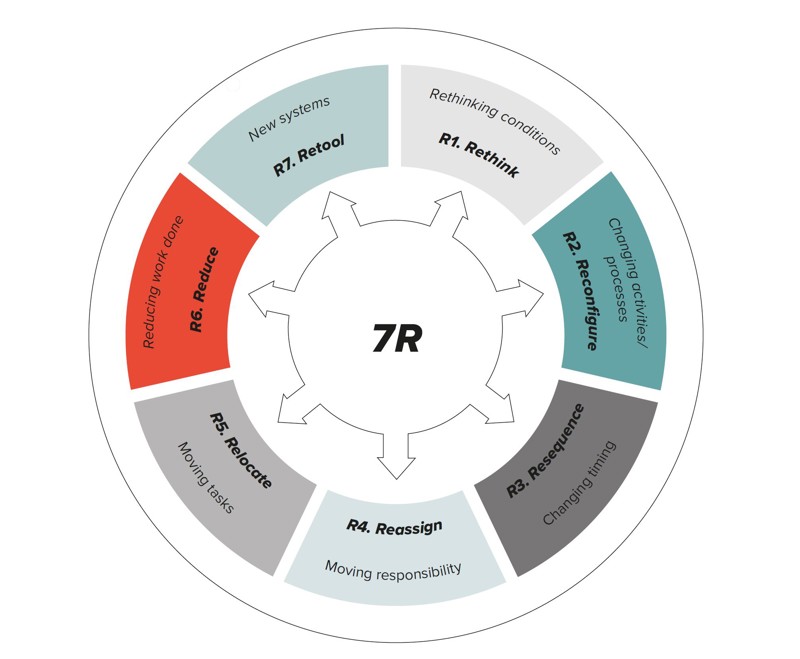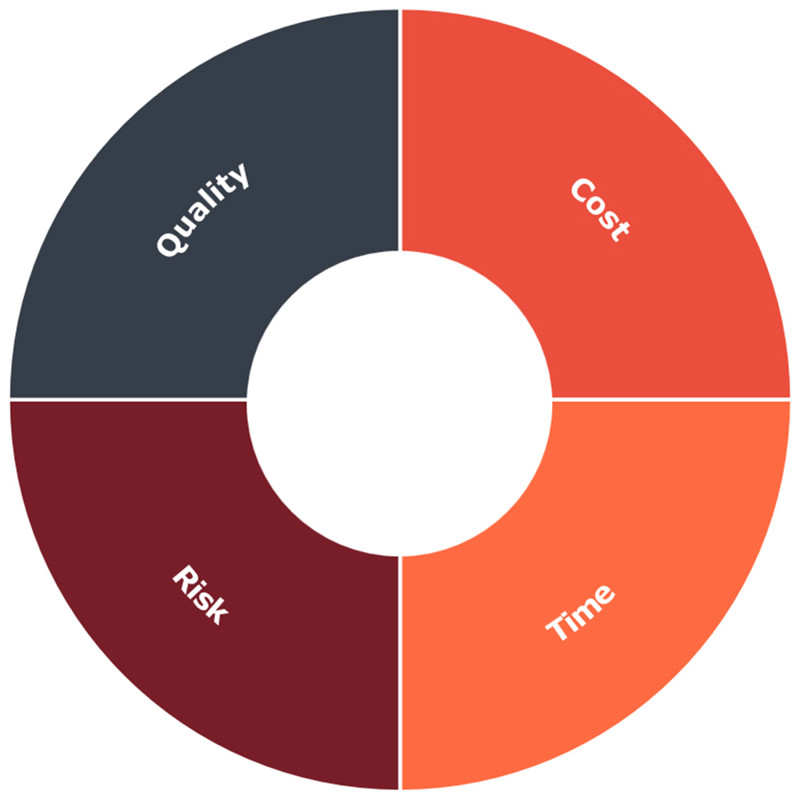"Most people ask questions about what went wrong in relation to what was agreed upon or ex-pected. However, support functions would be in a much better position if there were constant questions about all existing processes instead."
A large part of managing a support function – whether it be Finance, Legal, Facility Manage-ment, or HR – involves improving processes. Processes that once worked well tend to survive simply because that’s what we are used to doing. There are many approaches and tools when it comes to improving processes, but a good start could be a questioning framework.
If you don't ask the right questions, you won't get the right answers. The 7R model is a palette of questions that you can use to improve your company's processes – and in dialogue with the business as a business partnering tool.

The 7R model is a challenge model, where the core of the questions is: What if ...? We, at Basico, often use these seven points when discussing and assessing a process.
R1: Rethink (why)
When looking at a process, you can start by asking why we have this process in the first place. Does it add value? Why do we do this? What are the assumptions about why we do what we do? Also ask about time, money, speed, and quality in the process. What is most important?
R2: Reconfigure (how)
Can we in any way change what is included in each process step? Can the composition of activities in the process be different? What is best practice? Can we get inspiration from other companies or industries, for example through benchmarking?
R3: Resequence (when)
Can we change the timing? Can we do it in the evening or at night? Can we move it to the end of the month? Do we have to do it at the same time as the month-end closing? Can we pre¬pare part of the work and finish it later? Can we postpone the start until we know the final need?
R4: Reassign (who)
Can we get someone else to do this? Someone who is more skilled, or someone who costs less, is located elsewhere in the organisation, has better insight and/or competences, or where it would be more natural? Can we have external parties perform the work?
R5: Relocate (where)
Can we move it closer to production? Or perhaps abroad, where it is cheaper?
R6: Reduce (how much)
Can we reduce the number of process runs, the information desired, the requirement for quality, or the waiting time? Can we use statistics to predict the need to avoid doing too much?
R7: Retool (what)
Can we use the technology better? Can we automate subtasks and activities? How can we use existing or new assets to create process improvements?
Value in process discussion
7R is a simple model that you can incorporate into the discussion of process considerations. If you practice the palette of questions with your employees, leaders, or partners, you will come to better answers and solutions than if you just talk about the need to improve processes.
The model is very good at provoking answers that pave the way for the solution. For example, a major industrial company wanted to reduce the costs of its reporting process, which had re-ceived a poor benchmarking score. Initially, it was assumed that the ERP system had to be re-placed, and the entire process turned upside down to cut 15-20 per cent of costs. One of the first things uncovered with 7R was different perceptions within the organisation of the im-portance of getting information quickly, and of the meaning of 'accurate figures'.
For the new corporate management, it was acceptable to receive figures on day five instead of on day three, as required by the previous management. However, the new management would like KPIs daily and a summarised key figure three days after the turn of the month. On the other hand, the monthly reporting didn’t need to be 'to two decimals' to be correct.
By using the question palette and starting with R1 (rethink), the debate about process changes opened up. Especially R3 (resequence) and R4 (reassign) laid the foundation for en-tirely different possibilities in the process. The result was that it wasn’t necessary to invest in a new ERP system after all.
Use resources correctly
For many years, we have tended to just reduce the number of people in an organisation. In-stead, try to shake things up and consider whether resources can be redistributed more advantageously. Especially now, when it’s a worker's market, and new younger employees are entering the workplaces. Here, the method can also be used to consider what motivates the future workforce, what creates job satisfaction, what competences the new employees have, and what ongoing challenges (versus routines) are needed to retain, recruit, and motivate.
Sometimes it may be a good idea to invest in one expensive resource and several less costly ones solely in support of the expensive one.
There may be little waste in terms of the less costly resources, but the expensive resource is so valuable to the business that it’s an acceptable loss.
For example, the sales director is more valuable to the company if he or she spends time talking to (potential) customers rather than reviewing documents.
For example, the sales director is more valuable to the company if he or she spends time talk-ing to (potential) customers rather than reviewing documents. It may be that there is half an accountant too many, but overall, the resources are better utilised – even if the key figure for the accounting function is worsened, if considered in isolation.
A large Danish company has chosen to outsource and reduce the number of vouchers that must be approved by managers around the organisation. The company has decided that vouchers under 500 DKK no longer need to be approved at two levels. There is a clear policy for what can be purchased and what cannot, and management expects employees to adhere to the set rules. The number of invoices under 500 DKK constitutes a very small part of total costs, but relatively much time is spent on them.
As a leader in the company's sales department said: "I approve 99 per cent of all small bills when I see them. The last 1 per cent I often approve after having asked one of my employees. But it takes my time, and accounting has to chase me for approvals. If a couple of 500 DKK slip through, I believe I've earned it back in another way."
This policy may not work for you, but it’s a relevant question. Here, R1 (rethink) and R6 (re-duce) were in play: How can we reduce the number of vouchers that need to be approved? How can we move the time waiting for approved vouchers?
Also, try to balance the various priorities in a process: costs, time, quality, and risk, see figure 2.

Figure 2: Elements to be prioritised and balanced when choosing processes
If a process is designed to be the less costly, it may not meet desires for speed. Perhaps the quality is fine, but the risk is significant.
At the same time, it’s important to define the meanings of the terms costs, time, quality, and risk. An example we often use to illustrate the important differences doesn’t come from the world of processes:
You should design your choice based on what you want to achieve.
If one wants a fast car for under 1 million DKK, one might choose a Tesla. A Tesla is fast, and it accelerates from 0 to 100 km/h in a few seconds. It has a high top speed compared to many other cars in the same price range. But if it's about driving 1,000 km the fastest, Tesla loses be¬cause of the charging time, and then other, less costly cars would be a better choice.
Conversely, Tesla is a very good choice if it's about getting the fastest from 0 to 100 km/h and only driving a short distance. You should design your choice based on what you want to achieve.
Focus on the questions
You don't have to have all the answers yourself. It's about getting the questions into the dialogue to reach the best solutions; also questions that you think have already been answered or where the answer seems obvious. Perhaps overlooked nuances will emerge.
Most people ask questions about what went wrong in relation to what was agreed upon or ex-pected. However, support functions would be in a much better position if there were constant questions about all the existing processes instead. Therefore, make it a habit – in collabora-tion with all those involved – to ask critical questions before and during the processes.
Try it the next time you're in a process discussion with your colleagues or other partners, and see what happens.

Processes are key to effective support functions
Basico can offer sound advice developing and optimising processes. In this connection, 7R is a good and structured tool that delivers immediate results.
Contact us to learn more.

 en
en
 da
da

